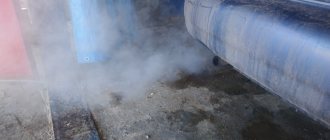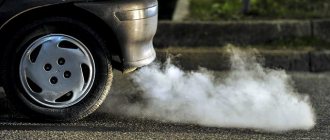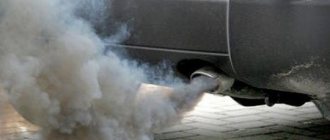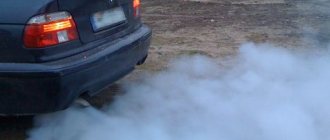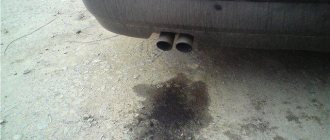20.05.2019
| (Votes: 8, Rating: 4.75) |
Issues discussed in the material:
- Why does thick white smoke come from the exhaust pipe of a gasoline engine?
- What can cause white smoke to come out of a diesel exhaust pipe?
- How to determine the cause of white smoke from the exhaust pipe of a gasoline engine
- How to Diagnose the Cause of White Smoke from a Diesel Exhaust Pipe
Usually in winter, most car owners do not pay attention to the fact that white smoke comes from the exhaust pipe. However, in the warm season, this looks at least strange, regardless of whether the car has a diesel or gasoline engine. The article talks about what the causes of strong white exhaust can be and how serious they are.
Why is there thick white smoke coming from the exhaust pipe: possible reasons
Do not immediately think that this is a sign of serious problems with the engine. Most often, smoke appears due to water vapor formed in the exhaust system. This usually happens during the cold season, when the outside temperature is no higher than plus five degrees. Then, when you start a cold engine, steam comes out. This phenomenon is also typical for wet weather, if it is rainy, cloudy or foggy outside. While the engine is running, the exhaust system warms up and the smoke stops coming out.
However, if strong white smoke comes out of the exhaust pipe when the engine is warm, this may indicate a malfunction. Here's how it shows up:
- White smoke comes out the moment you start the engine and does not stop even as it warms up.
- White puffs fly out if you press the pedal hard, but when the engine is idling, nothing like this is observed.
Experienced car owners can easily navigate such faults, accurately determine the cause and know how to eliminate it. But it’s more difficult for a novice driver, because in wet weather intense white smoke from the exhaust pipe is a common occurrence, and here you need to understand its intensity and duration. This can happen for various reasons.
- Clogged filters.
This may seem strange to some, but it is precisely because of dirty engine filters that the system can produce copious emissions, often even black. This happens because less air is supplied and more fuel is supplied.
- Technical malfunction.
Strong white smoke from the exhaust pipe in the warm season, even when the engine is idling, is a sure sign of a malfunction.
- Refrigerant leak.
Refrigerant may enter the manifold. How to recognize that this has happened? It will be seen that the coolant is consumed much faster, and the engine speed has become uneven. The important elements of an internal combustion engine are the head with the camshaft and the cylinder block. These structural components are separated by a gasket. In general, the entire system must be sealed so that there is no leakage of antifreeze, which provides protection against overheating. The problem may arise if the cylinder head is installed incorrectly, there are slight deflections, or the valve is burnt out.
- Wear of certain elements.
In the engine, the motor piston is equipped with a ring that limits the entry of lubricants into the fuel mixture. During operation, continuous friction occurs, in addition, there is a combustion chamber nearby, so parts wear out, become hard, or completely fail. As a result, the gaps increase and oil can get into the fuel.
We recommend
“How they deceive you at a car service center and what you can do to protect yourself” Read more
Harmless white exhaust
Immediately after starting a cold engine, the exhaust pipes and mufflers do not yet have time to warm up to a high temperature and act as a refrigerator for exhaust gases.
Therefore, at first, white smoke, or rather steam, will come out of the chimney of a perfectly good car. And the lower the temperature of the outside air, and therefore the parts of the exhaust system, the longer it will enter the thermal regime, gradually changing the intensity of the color of the gases. This must be taken into account and not panic if you accidentally notice white clouds in the mirror behind a car that has not had time to warm up. During short city trips in winter, the mufflers, due to their massiveness and low thermal energy of a modern economical engine, especially with a turbocharger, do not have time to heat up at all, and the cars hover constantly. You can see how, on large-volume engines, streams of water flow from the mufflers, which has managed to condense to the liquid phase. Often a puddle of this water is constantly located in the main rear muffler, sometimes even a small hole is made in its bottom to drain condensate and fight corrosion.
Design features of the power plant
All cars are very different, and there are many that differ in some design features. For example, Swedish SAABs, produced in the nineties, are equipped with a special valve with a vacuum hose. And if transmission oil ends up in the engine through it, then white smoke appears from the exhaust pipe.
This is not critical for the engine, but it will perform worse. Lubricants necessary for the normal operation of the structural elements of the gearbox eventually clog the glow plugs. This in turn suppresses the spark and, naturally, affects the efficiency of the engine.
Reasons for the appearance of white smoke from the exhaust pipe of a diesel engine
There are several defects that cause white exhaust:
- At the time of starting and warming up the engine, there was a lot of humidity in the muffler.
- Unburnt fuel remains in the diesel engine.
- Antifreeze penetrates into the combustion chamber.
As for the appearance of white exhaust due to moisture collected in the muffler, this is a normal phenomenon. When the engine starts, a little accumulated moisture simply flows out, and what does not flow out rapidly evaporates during the warming up process and gives the exhaust a white color. The smoke stops coming out after the system has warmed up sufficiently and the condensate has completely evaporated.
The second of these reasons is incomplete combustion of fuel, delay in its ignition. Moreover, this happens not only in case of malfunctions in a diesel engine, but also in a normal working engine in the cold season.
If the diesel engine is working properly, but the fuel still does not ignite at the right time, it may be because the cylinder walls are not warmed up enough. White smoke is not considered a problem and will disappear after the engine warms up normally.
However, the appearance of white smoke from the exhaust pipe on a warm engine may indicate that:
- The plunger pairs in the fuel pump have become unusable.
- There is a problem with the spark plugs.
- There is insufficient pressure in the cylinders.
- The injection into the injectors occurs under too much pressure.
What do such problems lead to? In the engine, the angle of fuel injection changes, the moment of its ignition in the cylinders is delayed, so the engine can be difficult to start, not only when it has cooled down, but also when it is well warmed up. In this case, twitching may be observed when the diesel engine is idling, or it may stall if a load is applied.
In addition, there is a noticeable decrease in engine power: acceleration is more difficult and takes longer, more fuel is wasted, and the engine responds with a delay to pressing the gas pedal.
The third reason why white smoke pours out of the exhaust pipe is the most serious and poses the greatest danger specifically for diesel engines. Antifreeze that gets into the engine cylinders causes the formation of sulfur oxide, which significantly shortens its service life.
Most often, coolant ends up in the engine because:
- The sealing gasket in the cylinder head is worn or damaged.
- The cylinder head or the block itself is cracked (happens less frequently).
It happens that the intake manifold gasket is damaged, then antifreeze ends up in the combustion chamber through the fuel intake system.
It is important to pay attention to the problem in a timely manner, otherwise it may cause water hammer, the connecting rods will fail, or there may even be a need for a major overhaul of the engine.
We recommend
“Stages of engine diagnostics: what determines the sequence of work” Read more
Blue or gray smoke
The most likely cause of blue (“oil”) smoke is oil getting into the engine cylinders. “Oil” smoke can have different color shades: from transparent blue to thick white-blue. This depends on the operating mode of the engine, the degree of its warming up and the amount of oil entering the cylinders, as well as lighting and other factors. It is noteworthy that oil smoke, unlike steam, does not dissipate quickly into the air, and the paper test mentioned above produces greasy droplets flying out of the pipe along with the exhaust gases. It is also obvious that oil smoke is accompanied by increased oil consumption. Thus, at a consumption of about 0.5 l/100 km, bluish smoke appears mainly in transition modes, and when it reaches 1.0 l/100 km, also in uniform motion modes. By the way, in the latter case, during transient conditions, oil smoke becomes thick blue-white. True, owners of the most modern cars need to remember about the possible presence of a neutralizer that can clean the exhaust gases from oil even at fairly high costs.
Oil can enter the combustion chambers (cylinders) in two ways: from below, through the piston rings, from above, through the gaps between the valve stems and guide bushings. The most likely reason for the appearance of blue exhaust is wear of the cylinder-piston parts. The upper compression rings experience wear not only on the outer surface in contact with the cylinder, but also on the end planes that perceive the gas pressure in the cylinder. The grooves of these rings in the pistons may also be worn out. Large gaps in the grooves create a pumping effect. Even if the oil scraper rings are still normal, oil still enters the cylinders, since the upper rings continuously “pump” it from the bottom up.
Cylinders wear out the most in the stopping zone of the upper ring when the piston reaches top dead center, and in the middle part they often take on an oval shape. Deviation of the cylinder shape from the circle impairs the sealing properties of the rings. Gaps usually form in the area of the locks, but it is possible that they may appear in other places around the circle.
There are cases when, although the ring and piston are in relatively good condition, the cylinder surface is damaged. This happens, for example, when oil filtration is poor, when abrasive particles get between the piston and cylinder skirts, resulting in scratches on the cylinder. A similar situation is real after a long period of parking, when traces of corrosion may appear on the surface of the cylinders and rings. It will take considerable time to smooth out these defects and to mutually break in the parts (if they can break in at all).
The same effect often occurs when engine repair techniques are violated, when the surface of the rebuilt cylinder is too rough or the cylinder is of the wrong shape, or they used poor quality pistons or piston rings that do not meet the engine specifications. In such cases, normal engine operation should not generally be expected.
Wear of the cylinder-piston group is often accompanied by a loss of compression and an increase in pressure in the crankcase, which is determined by the corresponding devices (compressometer, leak tester, etc.). However, remember that a large amount of oil entering the cylinders well seals the gaps in the mating parts. If the gaps are not too large, then the result of the compression assessment can be quite normal, sometimes even closer to the upper limit. It is this circumstance that confuses the search for specific causes of oily blue smoke.
When there is no significant wear of parts, then blue or blue-white smoke is clearly observed only when the engine is running in warm-up mode, gradually decreases and even disappears altogether. The reason is simple: when heated, the parts expand and occupy more space, in which they are pressed harder against each other. If there is excessive wear, the picture is the opposite: the amount of smoke on a warm engine will increase, since it is easier for hot oil, which has a low viscosity, to enter the cylinder through worn parts.
It is always easier to identify a fault if it is associated with more severe forms of wear or even broken parts. Thus, significant detonation can occur, which leads to damage to the bridges between the rings on the pistons, at least damage to the rings themselves is most likely. Severe overheating of the engine causes deformation of the piston skirt, creating a large gap between the piston and the cylinder. A deformed piston warps, disrupting the operation of the rings. The same result is possible when the connecting rod is deformed, for example, due to water hammer when water gets into the cylinder or after a belt breaks and the piston hits an open valve.
Using low-quality oil can lead to ring burnout or sticking in the piston grooves. The use of low-quality oil can cause the rings to burn and stick in the piston grooves. And due to prolonged glow ignition, the rings can simply be rolled into the grooves with a complete loss of mobility.
The above defects usually do not occur in all cylinders at once. It is not difficult to find a faulty cylinder by comparing the condition of the spark and compression plugs in different cylinders. Moreover, such defects are often accompanied by various kinds of noise and knocking, which change with speed, load and degree of engine warm-up, as well as unstable engine operation due to cylinder shutdown (especially during a cold start). A common group of problems that cause oil smoke and oil consumption are associated with wear of valve stems and guides, as well as wear, mechanical defects and aging (loss of elasticity) of valve stem seals. These defects, as a rule, give a noticeable increase in engine smoke as it warms up, since the diluted hot oil passes much more easily through the gaps between worn parts. In addition, oil penetration into the cylinders increases at idle and during engine braking. In these modes, a large vacuum occurs in the intake manifold, and oil flows along the valve stems under the influence of a pressure difference, accumulating on the walls of parts and in the exhaust system. Subsequent opening of the throttle valve at the first moment sharply increases the density of the blue oil smoke.
For turbocharged engines, oil consumption accompanied by blue smoke is possible due to a malfunction of the turbocharger, in particular wear of the bearings and rotor seals. Wear of the front bearing seal of the compressor gives a picture similar to the failure of the valve stem seals (including oil deposits on the spark plugs), but at the same time a puddle of oil collects in the compressor inlet pipe. A turbine seal failure is difficult to determine because the oil goes directly into the exhaust system and burns out there.
In operation, blue smoke and oil consumption often appear when one of the cylinders is turned off due to an ignition fault or when the valves are leaking. In the latter case, the smoke becomes white-blue, especially if the valve has an obvious burnout. Such a defect is easily determined - the compression in this cylinder is insignificant or completely absent, and abundant black soot appears on the spark plug, often in the form of growths.
How to determine why white smoke is coming from the exhaust pipe of a gasoline engine
First, carry out a simple inspection: pull out the oil dipstick and check not only the volume of oil, but also what it looks like, has a whitish color appeared, has an emulsion formed? Water getting into the oil often damages the engine.
A characteristic manifestation of such a problem is not white, but even bluish smoke. It leaves a whole foggy cloud behind the car.
Look into the expansion tank. If you smell exhaust fumes and there is a barely noticeable oil film on the antifreeze, these are bad signs.
Another way to tell if water has entered the cylinder is to look at the carbon deposits on the spark plug. In this case, it will be completely clean, as if it had just come from the store, or even wet.
You can understand why white smoke is pouring out of the exhaust pipe using a simple white napkin, which you need to bring to the muffler with the engine running. The napkin will not become dirty if the cause of the smoke is ordinary condensation. Otherwise, noticeable oil marks will appear on it. Leaking antifreeze will leave a sour odor and yellowish or bluish prints. If any of these signs appear, you should climb into the engine and find the cause of the problem.
The gasket may be damaged, the block head or the block itself may be cracked. By the way, when the gasket is broken, the engine suffers.
To detect visible defects, all surfaces should be examined very carefully: the block itself, the block head, the surface from the inside, the intake and exhaust valves and the surrounding areas. It is not always possible to visually notice a crack; pressure testing is often necessary. With large defects, fluid accumulates above the piston. In this case, do not put off car repairs until later, otherwise a water hammer may occur.
For example, an inspection showed that the pressure in the radiator is normal and there is no smell of exhaust gases, but white smoke still comes out, the emulsification process has begun in the oil, and the liquid is consumed too quickly. These are all sure signs that the intake system is leaking fluid. Then you don’t have to remove the head, but just carefully examine the collector.
In general, the root cause of thick, light-colored exhaust is a malfunction of the cooling device, which in turn leads to overheating of the engine. Therefore, it is this problem that needs to be solved; it will not be enough to simply eliminate minor defects that cause white smoke to appear.
What happens in the combustion chamber
As a result of combustion of a mixture of gasoline and air, carbon dioxide and water are formed. Nitrogen passes through the cylinders with almost no chemical reaction, and oxygen is completely consumed when the power system is properly adjusted.
High temperature allows water to be in the gas phase, that is, the steam is transparent. This happens until the amount of water per unit volume exceeds the maximum permissible threshold, beyond which partial condensation of steam begins, and additional substances, except air and gasoline, do not enter the cylinders. The condensation limit depends on the temperature; the higher it is, the more water the gases can hold without the appearance of small droplets of visible vapor. It is this steam that gives that characteristic milky color.

